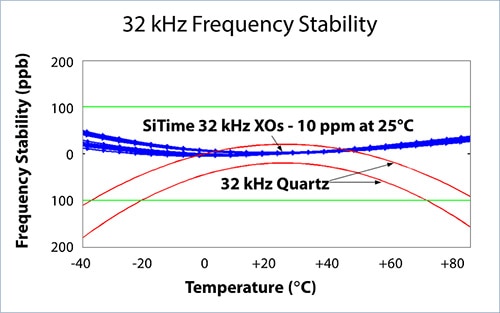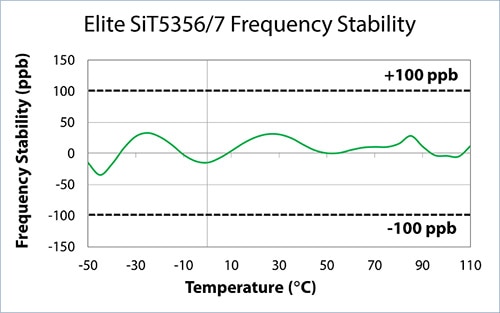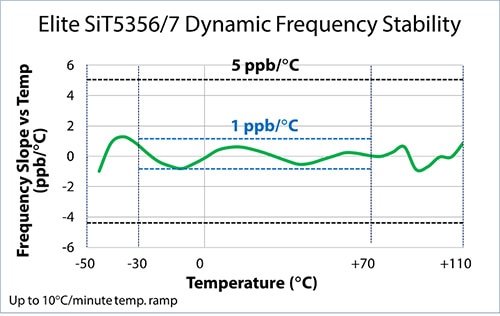Three Indications that May Cause You to Consider a New Timing Supplier
You’ve probably noticed that problems eventually arise when using quartz timing solutions. These devices have a tendency to act up, particularly in high stress conditions. Furthermore, their reliability is not always the best.
One solution, switch to MEMS timing devices. These devices don’t have the difficulties the quartz timing devices do. Below are three indications that switching to MEMS timing devices would be beneficial.
1. More stability is required
The one thing you need from timing is stability. With MEMS timing solutions, there is better stability exhibited on every level.
- Frequency stability – According to SiTime, their MHz and kHz oscillators have stability ratings that are two times better (±10 ppm) than typical quartz oscillators with their Elite Super-TCXOs offering stabilities as good as ±0.05 ppm. For example, the SiTime TempFlat™ MEMS 32 kHz devices have <10 ppm at 25°C (room temp) and <75 to 100 ppm over the entire industrial temperature range. Quartz crystals (XTALs), on the other hand, demonstrate a 20 ppm variation at 25°C and -160 to -200 ppm over temp.
 SiTime 32 kHz oscillators frequency variation compared to 32 kHz quartz crystal resonators. (Image source: SiTime)
SiTime 32 kHz oscillators frequency variation compared to 32 kHz quartz crystal resonators. (Image source: SiTime)
- No activity dips or micro jumps – SiTime’s MEMS oscillators do not exhibit these sudden frequency shifts, which can cause system failure, that quartz devices are susceptible to
- Excellent aging – Because SiTime MEMS devices are vacuum sealed, exhibit virtually no hysteresis, and suffer very little fatigue, their deterioration due to aging is two times better (over 10 years)
 The Elite Super-TCXOs frequency stability of ±0.1 ppm is well within spec over temperature. (Image source: SiTime)
The Elite Super-TCXOs frequency stability of ±0.1 ppm is well within spec over temperature. (Image source: SiTime)
2. Under stress, bad things happen
The ups and downs of quartz can be tiring. With the ability of SiTime’s MEMS timing products to withstand high temperatures, rapid thermal gradients, high airflow, mechanical shock and vibration, power supply noise, and electromagnetic interference (EMI), these ups and downs can be avoided. This is because they are built with groundbreaking technology that can easily cope with these problems.
 Elite Super-TCXOs exhibit a frequency slope of ±0.1 ppm with up to 10°C/minute temperature ramp. (Image source: SiTime)
Elite Super-TCXOs exhibit a frequency slope of ±0.1 ppm with up to 10°C/minute temperature ramp. (Image source: SiTime)
Under dynamic conditions, Elite Super-TCXOs feature excellent dynamic stability:
- < 5 ppb/°C frequency slope ΔF/ΔT at 10°C/min ramp
- 3e-11 ADEV at 10 second average time
- 0.1 ppb/g vibration immunity
- 0.2 ps/mV power supply noise rejection (PSNR)
3. Supplier reliability
Designed and produced using robust 6-Sigma methods, SiTime products are very reliable and durable because their manufacturing processes combined with the small mass and unique design of their MEMS devices, advanced analog technology, and the superior quality of single crystal silicon make this possible.
- < 2 DPPM failure rate – this is among the best in the semiconductor industry. Quartz devices that have typical failure rates of 50 to 150 DPPM.
- < 1 FIT rate – which translates to over 1 billion hours MTBF (mean time between failure). This is 30 times better than typical quartz products.
SiTime prides itself in being a dependable supply partner. They can leverage the massive semiconductor industry and its immense capacity because their devices are made with silicon. Unlike quartz, SiTime can easily scale and doesn’t have a specialized and capital-intensive manufacturing supply chain. Plus, since their products are built on a programmable architecture, this enables millions of specification combinations. Customers have the ability to order any frequency, any supply voltage, and any stability within a wide range.
It’s not complicated with MEMS
If quartz products aren’t delivering the performance, reliability or features required, it’s a sure sign that you need to switch. MEMS oscillators are simply more stable, robust, and reliable. SiTime has designed their MEMS timing products to solve the most difficult timing problems and overcome the limitations of quartz. You’ll never go back once you get to know MEMS timing.

Have questions or comments? Continue the conversation on TechForum, DigiKey's online community and technical resource.
Visit TechForum











